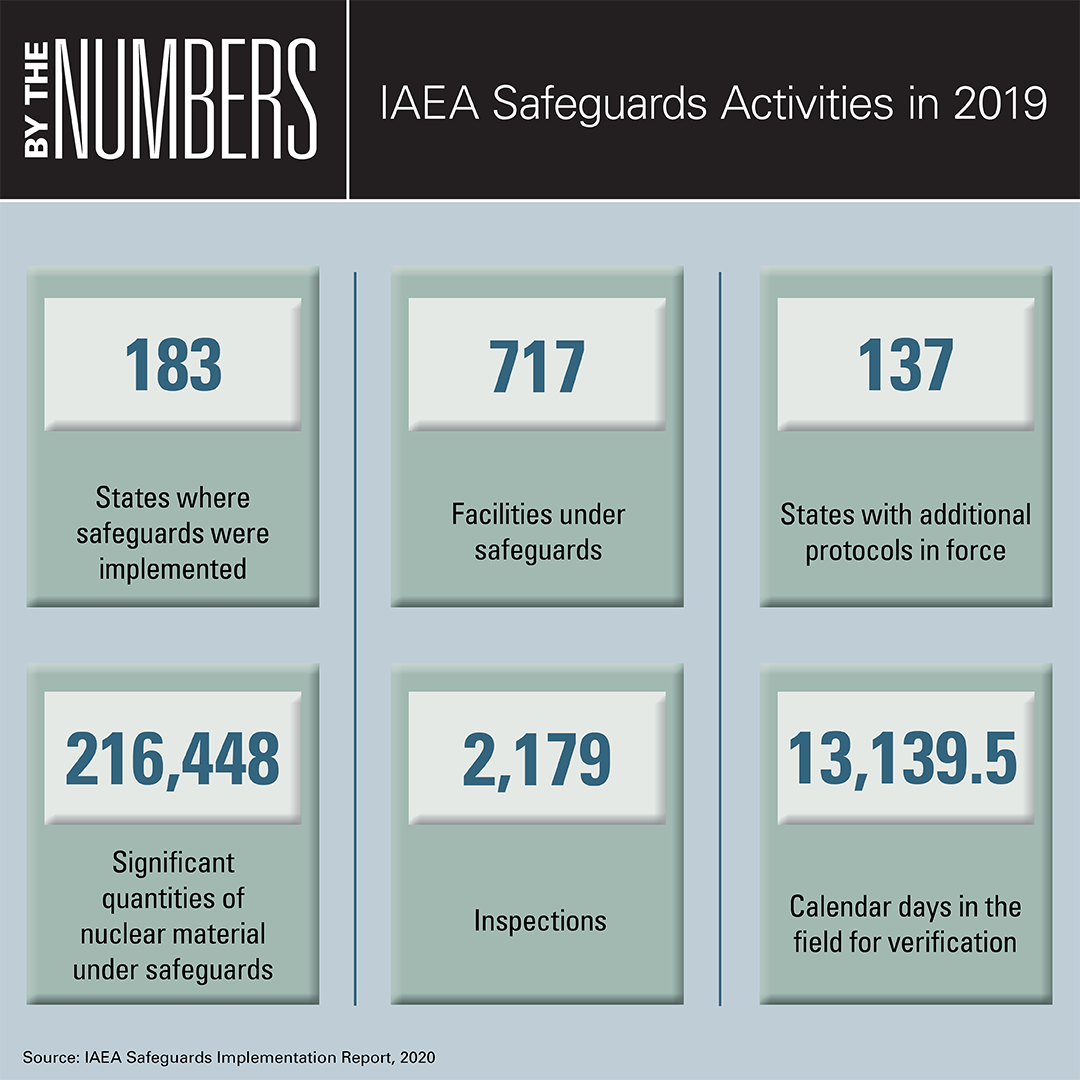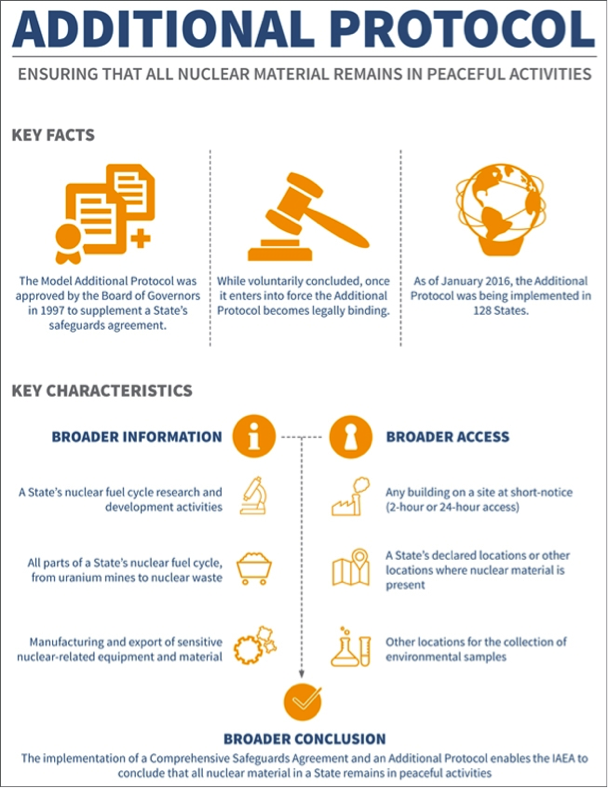Contact: Kelsey Davenport, Director for Nonproliferation Policy, (202) 463-8270 x102
Introduction
Safeguards agreements ensure that all nuclear activity a state undertakes is for peaceful purposes and that a state is not engaging in illicit nuclear activities. The International Atomic Energy Agency (IAEA), is the independent organization charged with applying safeguards.
 The IAEA and Canada concluded the first safeguards agreement in 1959 and in 1961, the IAEA’s Board of Governors approved a document outlining the principles of safeguards. Since 1961, both the scope and application of safeguards have evolved.
The IAEA and Canada concluded the first safeguards agreement in 1959 and in 1961, the IAEA’s Board of Governors approved a document outlining the principles of safeguards. Since 1961, both the scope and application of safeguards have evolved.
Under Article III of the 1968 nuclear Nonproliferation Treaty (NPT), all non-nuclear weapons states-parties are required to conclude a safeguards agreement with the IAEA, known as a Comprehensive Safeguards Agreement (CSA or INFCIRC/153 corrected). Given the near-universal membership in the NPT, safeguards are now widespread.
These agreements allow for states to exercise their right under the NPT to peaceful nuclear energy without causing concern that they may actually be developing nuclear weapons in violation of the treaty.
The five NPT nuclear weapons states (China, France, Russia, the United Kingdom and the United States) are not required to have IAEA safeguards agreements under the NPT. All five, however, have signed voluntary offer safeguards agreements that permit the IAEA to apply safeguards to material in select eligible facilities. This covers civilian nuclear material and sites. All five nuclear weapon states have also concluded additional protocols to the voluntary offer safeguards agreements.
States with minimal or no nuclear material may sign a small quantities protocol, abstaining them from some of the obligations under the Comprehensive Safeguards Agreement as long as they meet certain criteria. The small quantifies protocol was revised in 2005, and now contains fewer exemptions.
Non-states-parties to the NPT may also sign safeguards agreements with the IAEA known as item-specific safeguards agreements (INFCIRC-66). India, Pakistan and Israel for instance, have placed civil nuclear facilities under IAEA safeguards and India has an Additional Protocol in force.
IAEA safeguards measures do not prohibit additional bilateral or multilateral safeguards measures. For instance, Brazil and Argentina reached an agreement on bilateral safeguards inspections in 1991 (ABACC) and Euratom’s safeguards, which predated the NPT requirement, and contribute to its member states’ safeguards agreements negotiated with the agency.
Comprehensive Safeguards Agreement (CSA)
The Comprehensive Safeguards Agreement (CSA) is required for non-nuclear-weapon states under the NPT and is an option for non-NPT members. In concluding a CSA with the IAEA, states must declare the type and quantity of material subject to safeguards in an initial report. The IAEA verifies that a state’s declaration of nuclear material is correct and complete. A CSA also gives the IAEA the authority to independently verify that all nuclear material in the territory or jurisdictional control of a state is not diverted for nuclear weapons or explosives purposes and that nuclear facilities are not misused.
The IAEA notes four main processes for the implementation of safeguards.
- Collection and evaluation of safeguards-relevant information: The IAEA collects safeguards-relevant information to determine if a state’s declarations about its nuclear program are correct.
- Development of a safeguards approach for a state: A safeguards approach indicates which safeguards measures are needed to verify a state’s declarations.
- Planning, conducting and evaluating safeguards activities: The IAEA then develops a plan to conduct the safeguards activities based on the safeguards approach and identifies areas that may need to be followed up.
- Drawing of a safeguards conclusion: Upon completing the safeguards implementation cycle, the IAEA issues safeguards conclusions, which provide credible assurances to the international community that states are abiding by safeguards commitments.
According to the IAEA, there are 182 states with Comprehensive Safeguards Agreements, as of September 2024. Four NPT member states have yet to negotiate Comprehensive Safeguards Agreements with the IAEA. Each year the IAEA reports on safeguards implementation to the agency’s Board of Governors, which is comprised of IAEA member states.
Strengthening Safeguards
The International Atomic Energy Agency (IAEA) began an effort in 1993 to better constrain NPT member-states' ability to illicitly pursue nuclear weapons after secret nuclear weapons programs in Iraq and North Korea exposed weaknesses in existing agency safeguards.
Program 93+2
Iraq, an NPT state-party, successfully circumvented IAEA safeguards by exploiting the agency's system of confining its inspection and monitoring activities to facilities or materials explicitly declared by each state in its safeguards agreement with the agency. To close the "undeclared facilities" loophole, the IAEA initiated a safeguards improvement plan known as "Program 93+2." The plan's name reflected that it was drafted in 1993 with the intention of being implemented in two years.
Putting "Program 93+2" into effect, however, took more time than expected, and the program has subsequently been implemented in two parts. The IAEA, within its existing authority, initiated the first part in January 1996. This first step added new monitoring measures, such as environmental sampling, no-notice inspections at key measurement points within declared facilities, and remote monitoring and analysis.
Modified Code 3.1 of the Subsidiary Arrangements to a Safeguards Agreement
Modified Code 3.1 requires countries to submit design information for new nuclear facilities to the IAEA as soon as the decision is made to construct, or authorize construction, of the facility. Modified Code 3.1 was introduced in the early 1990s to replace the 1976 code, which only required states to inform the IAEA of new facilities not later than 180 days before the introduction of nuclear material. States that implement Modified Code 3.1 provide the IAEA with additional time to respond to a state’s expansion of its nuclear program and to adjust safeguard agreements as needed.
The Model Additional Protocol (AP)
The second part of "Program 93+2" required a formal expansion of the agency's legal mandate in the form of an additional protocol to be adopted by each NPT member to supplement its existing IAEA safeguards agreement. The IAEA adopted a Model Additional Protocol on May 15, 1997. The essence of the Additional Protocol is to reshape the IAEA's safeguards regime from a quantitative system focused on accounting for known quantities of materials and monitoring declared activities to a qualitative system aimed at gathering a comprehensive picture of a state's nuclear and nuclear-related activities, including all nuclear-related imports and exports. The Additional Protocol also substantially expands the IAEA's ability to check for clandestine nuclear facilities by providing the agency with authority to visit any facility, declared or not, to investigate questions about or inconsistencies in a state's nuclear declarations. NPT states-parties are not required to adopt an Additional Protocol, although the IAEA is urging all to do so.
The model protocol outlined four key changes that must be incorporated into each NPT state-party's Additional Protocol.
- Expanded amount and type of information to be provided to the IAEA
- In addition to the current requirement for data about nuclear fuel and fuel-cycle activities, states will now have to provide an "expanded declaration" on a broad array of nuclear-related activities, such as "nuclear fuel cycle-related research and development activities—not involving nuclear materials" and "the location, operational status and the estimated annual production" of uranium mines and thorium concentration plants. Thorium can be processed to produce fissile material, the key ingredient for nuclear weapons.
- All trade in items on the Nuclear Suppliers Group (NSG) trigger list will have to be reported to the IAEA as well. The NSG is a group of 48 nuclear supplier countries that seeks to voluntarily prevent the use of peaceful nuclear technology for military purposes by restricting nuclear and nuclear-related exports.
- Increased number and type of facilities the IAEA can inspect
- In order to resolve questions about or inconsistencies in the information a state has provided on its nuclear activities, the new inspection regime provides the IAEA with "complementary," or pre-approved, access to "any location specified by the Agency," as well as all of the facilities specified in the "expanded declaration."
- By negotiating an additional protocol, states will, in effect, guarantee the IAEA access on short notice to all of their declared and, if necessary, undeclared facilities in order "to assure the absence of undeclared nuclear material and activities."
- Streamlining the visa process for inspectors
- The agency's ability to conduct short notice inspections is augmented by streamlining the visa process for inspectors, who are guaranteed to receive within one month's notice "appropriate multiple entry/exit" visas that are valid for at least a year.
- Increased right to use environmental sampling
- The Additional Protocol provides for the IAEA's right to use environmental sampling during inspections at both declared and undeclared sites.
- It further permits the use of environmental sampling over a wide area rather than being confined to specific facilities.

As of September 2024, 142 member states and Euratom have concluded Additional Protocols that are now in force. Another 12 states have signed Additional Protocols but have yet to bring them into force. Iran applied its Additional Protocol provisionally beginning in January 2016 as part of the 2015 nuclear deal, but suspended implementation in February 2021.
Although the Additional Protocol is widely accepted as a standard safeguards practice, several states have opposed the expansion of safeguards to include it.
Integrated Safeguards
In addition to strengthening safeguards through the adoption of the Model Additional Protocol, in the late 1990s and 2000s, the IAEA also developed methods to improve the efficiency and efficacy of safeguards implementation for states with both CSAs and APs in force. The IAEA began using a “state-level concept” to evaluate a state’s compliance with safeguards agreements comprehensively, instead of on a facility-by-facility basis. It also began issuing “broader conclusion” determinations for states in order to ease safeguards implementation burdens by applying the state-level approach.
Broader Conclusion
The IAEA began issuing a “broader conclusion” designation for certain states with both the CSA and AP in force as part of a continuing effort to improve the efficiency and efficacy of safeguards and to cut costs. The IAEA must recertify a broader conclusion each year, verifying that a state’s declaration is both correct and complete. In other words, all nuclear material must remain in peaceful purposes with no indication of diversion and there must be no evidence of undeclared nuclear materials or activities.
If the IAEA derives a broader conclusion for a state, it may implement “integrated safeguards,” which are tailored to each individual state. Therefore, the resulting safeguards enforcement for that state becomes less burdensome and less costly.
The first state with a broader conclusion was Australia in 1999. The IAEA drew broader conclusions for 74 states in December 2023.
State-Level Concept
Over the years, the IAEA has also developed the state-level concept, which has become the designation for an integrated safeguards approach. Under the state-level concept, the IAEA considers each state as a whole when implementing and evaluating safeguards, including nuclear-related activities and capabilities, instead of examining each facility in a given state separately. Based on the broader range of information, the agency can then tailor a safeguards approach to the specific country.
The term “state-level concept” was first used in an IAEA document in 2005 although the IAEA had been following the practice since the early 1990s. The state-level concept is used for all states with a Comprehensive Safeguards Agreement, an Additional Protocol in force, and a broader conclusion finding. In a 2013 report, the Director-General of the IAEA indicated his intent to continue to develop state-level approaches for safeguards implementation for additional states.
As of 2023, there are 135 states with a comprehensive safeguards agreement and a state-level approach. According to the IAEA safeguards statement for 2023, "these 135 states hold 97% of all nuclear material (by significant quantity) under Agency safeguards in states with a comprehensive safeguards agreement."
Note: This factsheet was previously titled “The 1997 IAEA Additional Protocol at a Glance.”
